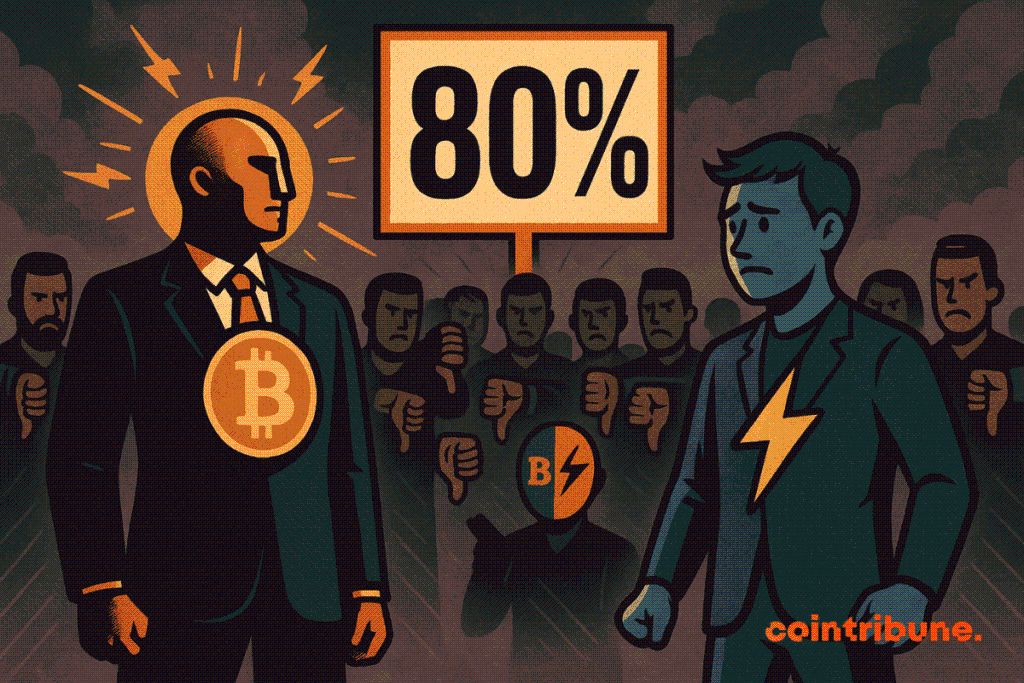Is the Lightning Network Losing Steam? The Numbers Raise Questions
An online survey sparked controversy: more than 80% of respondents believe that Lightning is not “real bitcoin.” A massive figure, and a clear divide between technical promise and market perception. The debate exploded on X, opposing pro-Lightning figures and sharp critics. Let’s summarize, decode, and project.

In brief
- A survey shows that 80% of respondents do not consider Lightning as real bitcoin
- The debate opposes critics mentioning complexity and liquidity dependence to defenders highlighting real use and micropayments
- Metrics stagnate while custodial products gain ground, hence the priority for a better UX and improvements like splicing.
Shocking survey, disrupted narrative
The message is harsh, for a large majority, Lightning does not embody “native” bitcoin. This perception is based on a simple intuition: if one must go on-chain to enter and exit the network, then Lightning appears as a separate environment, almost like a distinct token. The technical nuance, however, was not enough to convince.
In this context, the critics drove the point home. Paul Sztorc talks about a “cool system at first” that, over the years, “does not work.” He points out concrete constraints: nodes connected permanently, dependence on liquidity providers, need for watchtowers. For him, the user experience quickly slides toward custodial, and trust erodes.
On the other side, the response is clear. Alex Gladstein defends Lightning as a digital cash in bitcoin, without banks.
Matt Corallo adds a volume point: a double-digit share of BTC transactions would today be routed via Lightning. For them, the real-world reality already exists. The denial would, precisely, be to deny these uses.
The numbers that upset: stagnation and perceived centralization
Let’s look at the public metrics. The Lightning capacity is around a few thousand BTC , roughly the same level as in September 2022. No real surge in three years. The signal is clear: traction has not materialized at the hoped-for pace.
Another indicator, even tougher: the number of payment channels has almost halved since 2022, falling from over 80,000 to about 45,000. This is a marker of network density, surface, liquidity, and resilience. When channels diminish, the perception of centralization mechanically increases. And the “everyone can route everything” discourse loses credibility.
However, Lightning retains a key advantage: costs. Tiny payments, routed off-chain, sometimes approach a fraction of a cent. By contrast, on-chain bitcoin fees can devour hundreds of basis points on small amounts. On the “micropayments” axis, the technical advantage persists. But the narrative advantage, it wavers.
Competition from Bitcoin ETFs and revival avenues
Staying on the subject of perception, the context does not help. Volumes are exploding elsewhere, via ETFs. In Q3, JPMorgan observes a renewed interest in spot bitcoin ETFs , while wBTC-like and cbBTC progress. Apps like Moonshot, Base or Fomo boast onboarding in a few clicks, fast transactions, a smooth UX. The general public follows the slightest friction. And the bitcoin ecosystem pays for every step that seems too technical.
Should we bury Lightning? No. But we must tell the truth. The network has not converted the post-2022 trial. It remains powerful for specific cases: low-value recurring payments, “pay-per-use” models, targeted remittances. To scale, it lacks a “default” experience that hides the complexity of channels, liquidity, penalties, and connections. For market context, bitcoin trades today around the 106,000 $ mark at the time of writing, a symbolic milestone illustrating a moving ecosystem.
Disclaimer: The content of this article solely reflects the author's opinion and does not represent the platform in any capacity. This article is not intended to serve as a reference for making investment decisions.
You may also like
El Salvador government adds $100M worth of Bitcoin amid market dip

A surge in energy storage across North America is being fueled by aging power grids and a growing emphasis on clean energy.
- Canadian Solar secures 411 MW/1,858 MWh storage contract for Ontario's Skyview 2 project with Potentia and Algonquins First Nation, using SolBank 3.0 and 21-year service agreement. - North American energy storage market projected to grow at 16.1% CAGR through 2032, driven by aging grids and clean energy adoption, with Canadian Solar's 24,332 MWh pipeline reflecting industry expansion. - SolarEdge and Enphase expand storage capacities (500 MWh and 50 MWh respectively), with Zacks forecasting 25.4% and 9.4

Grab and StraitsX Join Forces to Enhance Cross-Border Payment Connectivity through Web3
- Grab and StraitsX partner to develop a Web3 wallet enhancing cross-border payments across Asia via blockchain technology. - StraitsX's regulated stablecoins (XSGD/XUSD) enable real-time fiat-crypto conversions, supporting Grab's superapp expansion in Southeast Asia. - The collaboration aligns with Singapore's 2023 stablecoin framework and regional initiatives like ASEAN RPC to modernize payment systems. - Grab's Q3 2025 $873M revenue and strategic focus on low-cost international transactions highlight th

Grab's Stablecoin Project Seeks to Simplify Cross-Border Payments in Southeast Asia
- Grab partners with StraitsX to develop Web3 wallet and stablecoin-based cross-border payment solutions for Southeast Asia. - Initiative aims to unify fragmented regional payments via real-time stablecoin settlements, enabling GrabPay merchants to accept XSGD/XUSD transactions. - Potential Grab-GoTo merger discussions in Indonesia remain unconfirmed, with Danantara Indonesia exploring minority stake in combined entity. - Grab reports $873M Q3 revenue but flat EPS, facing stock volatility amid mixed analys
